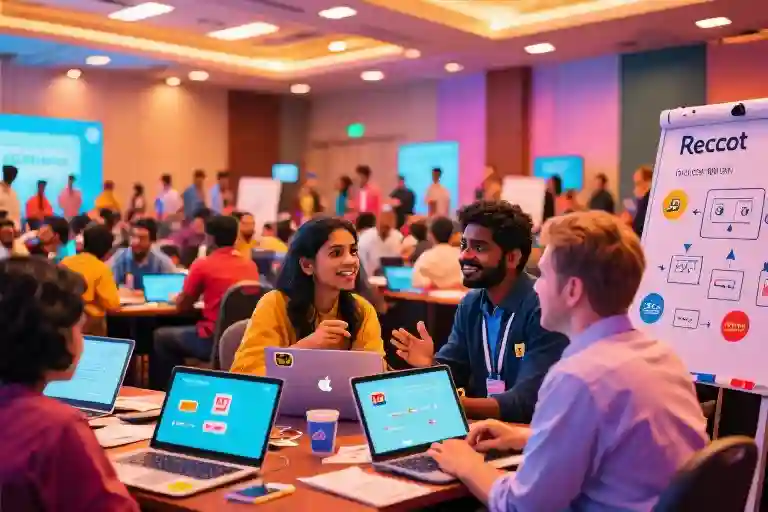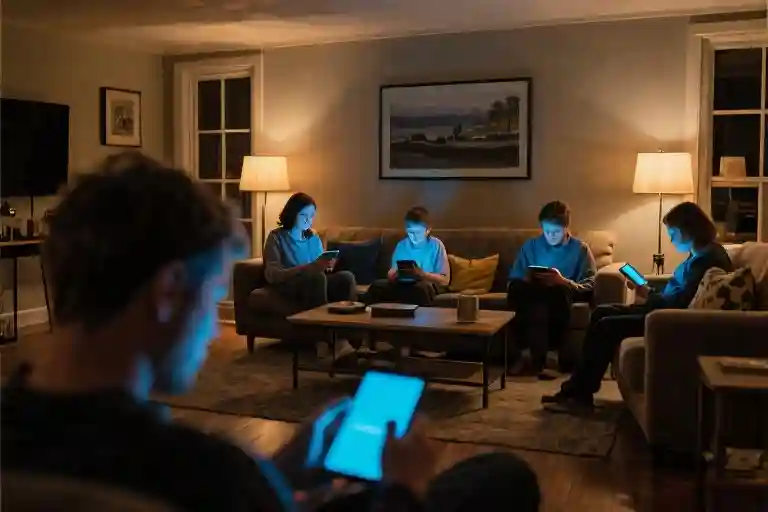The air in Bangalore carried that particular weight of impending rain, the kind that makes you instinctively check for an umbrella you know you forgot to pack. Walking into the J N Tata Auditorium, the humidity clinging to my skin gave way to something electric – not just the air conditioning, but the kinetic buzz of hundreds of developers reuniting, arguing, and sketching component trees on any available surface. Sticker-covered laptops snapped open like badges of honor. Conference lanyards swung as heads nodded in vigorous agreement over some arcane React optimization.
This was React Nexus 2025, and it felt like coming home to a family I didn’t know I had. Which immediately begged the question that had tickled the back of my mind since booking my flight: Why are we here? Not philosophically, but practically. In an age where the React docs update faster than my coffee order history, where AI pair programmers suggest context-aware hooks before I finish typing, where entire conference talk libraries live in my pocket – what possible justification exists for spending $1,200 on airfare and three PTO days to stand in a crowded Bangalore auditorium?
The answer wasn’t in the schedule or the slide decks. It was in the way a stranger stopped mid-corridor debate to include me, their hands animating an invisible state machine. It was in the speaker who recognized my ‘first-time attendee’ deer-in-headlights look and walked me not just to registration, but through their own rookie conference mistakes. This wasn’t knowledge transfer. This was kinship.
We’ve misunderstood what conferences sell. They’re not information delivery mechanisms – those broke when GitHub commits outpaced conference talk production. What React Nexus and its ilk provide is something far more primal: a temporary village where everyone speaks your secret language. The ticket price isn’t an access fee to talks; it’s a boundary that ensures every person who crosses it cares enough to have skin in the game. That selection bias creates something magical – a room where you can tap anyone on the shoulder and dive straight into the deep end of server components debate without the usual social preamble.
There’s a particular alchemy to these gatherings that no virtual space replicates. Online, we communicate in serial – messages passed back and forth with latency measured in hours or days. But here in the Bangalore convention center, interactions ran in parallel – a dozen conversations branching and merging like React Fiber’s reconciliation algorithm, with body language and whiteboard sketches providing the context no amount of Slack emoji could convey. The hallway track wasn’t just an amenity; it was the main thread, where talks went to get stress-tested against real-world use cases and speakers became temporary mentors.
This is the dirty little secret of our increasingly digital industry: the deeper we go into abstraction, the more we crave physical connection. We build systems to eliminate human latency, then voluntarily submit to the glorious inefficiency of face-to-face conversation. Because somewhere between the overpriced coffee and the jetlag, magic happens – the kind that can’t be memoized or shipped in an npm package. The kind that reminds us why we fell in love with this work in the first place.
The air in Bangalore carried that peculiar chill unique to monsoon season, damp with the promise of rain and thick with the energy of a thousand conversations about state management and component lifecycles. Walking into the J N Tata Auditorium for React Nexus 2025, the contrast struck me immediately – this wasn’t just another virtual meetup where cameras stay off and chat messages scroll into oblivion. Here, developers weren’t just usernames and avatars; they were real people with sticker-covered laptops, animated hand gestures, and that particular glow that comes from debating React Server Components over bad conference coffee.
A question had been nagging at me since booking my flight: Why do we still gather like this? In 2025, every conceivable technical resource exists online – exhaustive documentation, AI-powered code assistants, endless tutorial videos available at 2x speed. Yet hundreds of us chose to spend thousands on flights, hotels, and time away from families. The answer revealed itself before the first keynote began.
The registration desk became my first clue. Instead of the perfunctory badge handoff I’d expected, the organizer I’d met last year recognized me instantly. ‘You made it!’ he said, genuinely pleased, walking me through the venue like a host showing a friend around their home. Moments later, I found myself in an impromptu huddle with developers whose blogs I’d bookmarked for years, our conversation skipping past awkward introductions straight into the technical deep end. This wasn’t networking; it was reunion with people I simply hadn’t met yet.
What makes this experience worth the premium? The secret lies in the invisible filters. The ticket price, the travel commitment, the days sacrificed – these aren’t barriers but curation tools. Everyone in that auditorium had made a conscious choice to be there, signaling a level of engagement no free webinar registration could capture. Unlike corporate-mandated events filled with distracted attendees scrolling through emails, this crowd shared a singular focus. You could practically feel it in the air – that rare collective state where hundreds of minds simultaneously toggle into learning mode.
The magic wasn’t in the scheduled content (though the talks were excellent). It emerged in the spaces between – the coffee line debates about React compiler optimizations, the hallway whiteboard sessions comparing state management strategies, the dinner conversations that began with ‘What if we tried…’ and ended with napkin sketches of new architectural patterns. These unscripted moments formed the real conference, a living network of knowledge exchange no pre-recorded content could replicate.
This is the signal in the noise of our digital age. When technical knowledge has become commoditized, the scarce resource isn’t information – it’s the context, the shared struggle, the spontaneous collision of perspectives that happens when passionate people occupy the same physical space. The React Nexus organizers weren’t just selling access to talks; they were engineering the perfect conditions for human connection, creating an environment where every conversation had the potential to spark something transformative.
A Culture of Curiosity
The moment I stepped into the React Nexus crowd, I sensed something different in the air – not just the Bangalore humidity clinging to my shirt, but an almost tangible intellectual charge. This wasn’t the passive absorption of a classroom or the distracted multitasking of webinar attendees. Every conversation cluster thrummed with the energy of developers who’d traveled thousands of miles not just to hear, but to engage.
Someone had once joked that React developers share a common piece of state: const [mindset, setMindset] = useState('readyToLearn'). The metaphor held up beautifully here. You could spot it in the way attendees leaned forward during talks, fingers hovering over laptop keyboards ready to test a speaker’s claim in real-time. You heard it in the Q&A sessions where questions cut straight to implementation tradeoffs rather than surface-level explanations. Most tellingly, you felt it in those accidental coffee line encounters where ‘What brings you here?’ quickly escalated into passionate debates about server components adoption timelines.
What makes this brand of curiosity so potent is how it transforms social dynamics. Traditional networking events operate on forced intimacy – name tags, icebreakers, the transactional exchange of LinkedIn profiles. Tech conferences often inherit this awkwardness, leaving many developers (especially introverts) counting minutes until escape. But here, the technology itself became the ultimate social lubricant. No need for small talk when you can point to someone’s conference badge and ask, ‘I see you’re working on edge functions – are you using Vercel’s new runtime or rolling your own?’ Instant connection, zero preamble.
I watched this play out repeatedly near the sponsor booths. A developer would pause at a cloud provider’s display, squinting at their demo. Within minutes, they’d be sketching architecture diagrams with a stranger, debating the merits of cold starts versus global replication. What looked like casual chatter was actually high-bandwidth knowledge transfer – the kind that happens when people speak the same technical dialect fluently enough to skip straight to the interesting parts.
The warmth of these interactions wasn’t just professional courtesy. It emerged from shared battle scars – the late-night debugging sessions, the production outages, the ‘why won’t this rerender?’ frustrations that every React developer knows intimately. When someone mentions their struggle with concurrent rendering, you don’t just understand conceptually; your fingers remember the exact muscle tension from your own wrestling match with Suspense boundaries. This creates a peculiar intimacy among strangers, where discussing error boundaries can feel as vulnerable as sharing childhood memories.
Midway through day two, I found myself in one such conversation with an engineer from Oslo. We’d gotten stuck on a nuanced debate about state management in Next.js apps when three others joined unprompted, drawn by the technical tension. What followed wasn’t a polite exchange of opinions but a joyful intellectual brawl – laptops opened, code snippets flung like gauntlets, someone fetching whiteboard markers to diagram data flow. Two hours later, we emerged with solutions neither of us could’ve reached alone, plus that particular exhaustion that only comes from being mentally stretched.
This culture of curiosity creates a self-reinforcing cycle. The more participants engage deeply, the more others feel safe to abandon superficiality. By the conference’s end, even the most reserved developers were jumping into hallway debates, trusting that their half-formed ideas would be met with constructive pressure rather than dismissal. It’s the antithesis of Twitter hot takes – a space where complexity is honored rather than flattened, where ‘I don’t know’ marks the start of collaboration rather than the end of conversation.
What makes this environment so rare isn’t the intelligence of attendees (plenty of smart people exist online) but the deliberate cultivation of psychological safety. The conference’s design – from its single-track schedule encouraging shared experiences to its strictly enforced code of conduct – signaled that this was space for exploration, not performance. You could admit knowledge gaps without losing credibility, challenge ideas without personal attacks, and most importantly, stay genuinely open to being wrong.
Watching this culture in action clarified why so many attempts to replicate conference magic in digital spaces fall short. Slack channels and Discord servers might host similar technical discussions, but they lack the embodied cues – the nodding, the notebook scribbling, the collective leaning-in when an idea resonates – that accelerate trust and vulnerability. Online, we edit our thoughts into polished fragments. Here, we think aloud together, embracing the messy middle stages of understanding that rarely make it into blog posts or documentation.
Leaving the auditorium each evening, I’d overhear clusters of developers continuing sessions at nearby restaurants, whiteboarding on napkins between bites of biryani. Not because they had to, but because the culture had unlocked something fundamental – the pure joy of learning together, without pretense or posturing. That, more than any API demo or case study, is what sticks in memory long after the talks fade.
The Hallway Track
The real magic of React Nexus didn’t happen on stage. It happened in the spaces between – the coffee queues stretching around corners, the impromptu circles forming near power outlets, the quiet conversations in auditorium aisles after the house lights came up. This was the hallway track, the unscripted heart of the conference where ideas collided and relationships formed without an agenda.
What made these interactions different from typical conference networking? The complete absence of transactional energy. Nobody was here to collect business cards or pitch their latest product. When a senior engineer from a FAANG company spent forty-five minutes whiteboarding a state management problem with a junior developer from a small startup, there were no hidden motives. Just two people united by a shared technical challenge and the simple joy of problem-solving together.
The hallway track operated like a live, peer-reviewed journal for our industry, but one that moved at the speed of conversation. Official documentation provides stable reference points, but by nature, they’re frozen in time. Conference talks deliver polished insights, yet they remain largely one-directional. The hallway track transformed these static resources into living dialogues. An architectural pattern mentioned during a morning session would be stress-tested by afternoon against a dozen real-world implementations, debated over lunch tables, and refined through collective experience before dinner.
I witnessed this firsthand after my own talk. The scheduled Q&A time ended, but the conversation simply migrated to the corridor outside. Within minutes, I was surrounded by developers sharing how they’d adapted similar solutions, asking nuanced follow-up questions, and offering alternative approaches from their domains. One attendee pulled up a code snippet on their laptop that perfectly illustrated a pain point I’d described. Another connected it to an open GitHub issue we both hadn’t considered. This spontaneous collaboration lasted nearly an hour and yielded more practical insights than my prepared slides ever could.
These interactions followed a distinct rhythm. They began with technical specificity – ‘How did you handle hydration mismatches with that approach?’ rather than ‘So, what do you do?’ – immediately establishing common ground. The discussions then naturally branched into adjacent territories: workplace challenges, career advice, even recommendations for Bangalore’s best masala dosa. The technology served as both icebreaker and connective tissue, creating space for relationships to develop organically.
The hallway track’s value lies in its beautiful inefficiency. Online, we optimize for concise communication – threaded replies, character limits, clipped messages. Here, we embraced meandering conversations that doubled back, explored tangents, and occasionally dead-ended before finding new paths. This inefficiency became the feature, not the bug. It allowed for the serendipitous discoveries that structured formats often miss – the moment when someone’s offhand comment suddenly clarifies your months-long struggle with a legacy codebase.
For remote team members, I began collecting hallway insights like rare specimens – the senior architect’s unconventional debugging technique, the startup CTO’s hiring philosophy, the accessibility advocate’s CSS variable strategy. These weren’t takeaways I could Google later; they were lived experiences shared in context, complete with facial expressions, notebook sketches, and the occasional frustrated hand gesture when describing particularly gnarly bugs.
The most meaningful hallway moments often came unannounced. Waiting for a session to start, I overheard two engineers troubleshooting a performance issue. By the time the speaker took the stage, we’d formed an ad-hoc trio comparing notes, and left with a shared Slack channel to continue the conversation. Another time, a passing comment about testing strategies turned into a thirty-minute masterclass from a developer who’d written popular testing libraries. These interactions carried equal weight to the scheduled programming, perhaps more, because they responded directly to immediate, real-world needs.
What the hallway track offers can’t be replicated through virtual means. The multi-sensory nature of in-person communication – the ability to see when someone’s eyes light up with understanding, to sketch ideas on napkins, to share the collective groan when someone names that one deprecated API we’ve all wrestled with – creates bonds that transcend digital connections. It’s the difference between reading a recipe and tasting the dish someone prepared specifically for you.
This organic knowledge sharing represents the purest form of community. No stage separates experts from learners. No upvotes prioritize certain voices. Just developers of all levels exchanging ideas in the wild, validating concepts through immediate feedback, and building the informal networks that often outlast jobs and projects. The hallway track isn’t supplemental to the conference experience – it’s where the real conference happens.
Mentorship as a Core Component
The most unexpected revelation at React Nexus wasn’t about new framework features or performance optimizations. It was the quiet ubiquity of mentorship – not as a scheduled program, but as the oxygen that sustained the entire ecosystem. Senior engineers with fifteen years of experience would pause mid-conversation to diagram state management patterns on napkins for wide-eyed juniors. Library authors who’d built tools used by millions patiently explained their design decisions to curious attendees. This wasn’t performative expertise; it was the tech community’s circulatory system at work.
What struck me was how naturally these interactions flowed. At corporate hackathons, mentorship often feels transactional – senior developers assigned to ‘help’ teams with predetermined KPIs. Here, guidance emerged organically from shared curiosity. I watched a Google engineer spend forty-five minutes walking through compiler optimizations with a self-taught developer from Indonesia, their conversation punctuated by ‘what if we tried’ and ‘have you considered’ rather than ‘this is how it’s done.’ The power dynamic flattened when both parties treated problems as puzzles to solve together.
The conference environment acts as a mentorship accelerant. Online, reaching out to strangers feels intrusive – cold emails vanish into inbox voids. But when you’ve just heard someone articulate brilliant ideas on stage, approaching them feels natural. After my talk on performance profiling, three developers asked for career advice unrelated to my topic. One wanted to transition from agency work to product development; another sought guidance on public speaking. These conversations happened because the conference had already established common ground – we weren’t strangers, but temporary members of the same tribe.
This culture of giving first creates astonishing ripple effects. On the second day, I met a developer who’d flown from Brazil specifically to find collaborators for an accessibility-focused framework. By lunchtime, he’d connected with a Shopify engineer working on similar problems, a designer passionate about inclusive interfaces, and a Microsoft program manager scouting open-source contributors. None of these encounters were scheduled, yet they’ll likely shape careers and projects for years. That’s the magic of concentrated expertise in physical space – serendipity becomes strategy.
The most poignant mentorship moment came unexpectedly. A junior developer approached me after a panel, visibly nervous. ‘Your first blog post about React hooks helped me land my job,’ she said. ‘Now I’m terrified to write my own.’ For thirty minutes, we talked through her impostor syndrome, the vulnerability of publishing imperfect thoughts, and how every expert was once a beginner faking it. As we parted, she admitted, ‘I thought I needed technical mentoring. Turns out I just needed permission to be a work in progress.’ That exchange crystallized what makes tech conferences uniquely valuable – they’re safe spaces to be incomplete, to ask naive questions, and to remember everyone, even the speakers you admire, started somewhere.
What React Nexus demonstrated was that sustainable tech ecosystems don’t grow from documentation alone. They require senior developers willing to invest time in newcomers, mid-level engineers open about their stumbles, and juniors brave enough to say ‘I don’t understand.’ The conference didn’t just transfer knowledge – it perpetuated a culture where growing others isn’t extracurricular, but fundamental to how we advance the craft together.
Investing in the Human Network
The economics of modern tech conferences defy conventional logic. In an era where React documentation updates ping our notifications before coffee brews and AI pair programmers suggest optimizations mid-keystroke, the decision to spend $1,200 on a conference pass feels almost rebellious. Yet standing in that Bangalore auditorium, watching developers willingly disconnect from their digital lifelines to engage in analog conversations, the underlying value proposition became clear: we weren’t paying for information, we were investing in bandwidth.
Consider the math. The average React developer consumes approximately 37,000 words of technical content monthly – GitHub issues, blog posts, Stack Overflow threads – most available at zero marginal cost. Yet this abundance creates its own poverty. The signal-to-noise ratio plummets as we wade through outdated tutorials, contradictory advice, and LLM-generated fluff. React Nexus implemented a brutal but effective filter: the combined cost of tickets, flights, and hotels acted as a proof-of-work algorithm, ensuring every attendee had skin in the game. This wasn’t paywalling knowledge; it was creating a high-stakes environment where engagement mattered.
Physical gatherings resolve the fatal flaw of digital communities – the tyranny of low-context interactions. Online, we parse intent through the narrow pipe of text, losing vocal inflection, facial microexpressions, and the spontaneous whiteboard sketches that often convey more than paragraphs of documentation. The conference hall restored our full communicative spectrum. I watched TypeScript debates unfold with hands slicing air like conductors, saw complex state management problems solved through napkin diagrams, witnessed job offers materialize from coffee spills and subsequent laughter. These were multi-modal exchanges no Zoom call could replicate.
The hallway track operated like a live GitHub repository for social capital. Unlike LinkedIn connections – those hollow metrics accumulating dust in our professional dashboards – conference relationships came pre-loaded with context. When someone mentioned their work on authentication middleware, you’d already seen their eyes light up during yesterday’s security talk. These weren’t abstract professional profiles but whole humans whose technical passions you’d witnessed firsthand. The ROI became evident when comparing outreach response rates: cold emails to engineering managers typically see 3-5% replies, while conference follow-ups in my experience consistently hit 40-60%.
This bandwidth advantage manifests most clearly in mentorship dynamics. Digital mentorship programs often degenerate into calendar invites and structured agendas, while conference guidance flows as naturally as the chai in the venue’s break area. I observed senior engineers organically adopting mentees after casual conversations about shared technical challenges. The magic wasn’t in scheduled office hours but in the unplanned moments – walking together between sessions, waiting in lunch lines, or that golden hour when jet lag had half the crowd awake at 3 AM in the hotel lobby. These were the conditions where real technical wisdom transferred, wrapped in personal stories and punctuated by spontaneous questions.
What we monetize reveals what we value. The fact that thousands of developers willingly convert dollars into face time signals a fundamental market truth: in the attention economy, human connection has become the ultimate luxury good. React Nexus didn’t sell tickets – it sold permission to press pause on the endless scroll of content consumption and participate in something rarer: collective presence. As I boarded my return flight, the calculus felt different. That $1,200 wasn’t an expense line item; it was a down payment on relationships that would compound through my career. The code we write may live in the cloud, but our careers are built handshake by handshake, coffee by coffee, in the messy, glorious bandwidth of physical space.
A Speaker’s Perspective
The walk from the green room to the stage at React Nexus felt longer than the flight to Bangalore. My palms were damp, my heartbeat loud enough that I worried the mic might pick it up. The classic signs of impostor syndrome had arrived right on schedule: Is this topic actually useful? Will anyone care about these implementation details? What if I blank out mid-sentence?
Every speaker knows this ritual of self-doubt. My manager’s advice echoed in my head—Everyone starts somewhere—but in that moment, it did little to calm the nerves. The terrifying truth about conference speaking is this: No amount of rehearsals can simulate the vulnerability of standing alone under bright lights, offering your hard-won knowledge to a room full of people silently judging its worth.
Then something remarkable happens. You begin speaking. The first few sentences stumble out, but then muscle memory takes over. You glance at the audience and see it—the subtle nods, the hastily opened laptops taking notes, the sudden eyebrow raises when you reveal that one counterintuitive optimization trick. That’s when you spot your first A-ha! face. There’s nothing quite like witnessing the exact moment when your words help someone connect mental dots they’ve been struggling with. It’s an addictive rush, this tangible proof that your hours of preparation just made someone else’s work life slightly easier.
But here’s the secret most speakers won’t admit: The talk itself is merely the opening act. The real magic unfolds afterward in the hallway swarm. Before I’d even stepped off the stage, a cluster of attendees had formed near the exit, ready to dissect my presentation. One engineer pulled up a code snippet on her phone showing how she’d implemented a similar pattern with surprising results. Another challenged my approach with a production-edge case I hadn’t considered. This wasn’t passive consumption—it was collaborative refinement, the community stress-testing ideas in real time.
This dynamic reveals the speaker’s true role in a technical community. We’re not oracles dispensing wisdom from on high. We’re conversation starters, human catalysts for the far more valuable discussions that happen after our microphones go silent. Preparing a conference talk forces an unnatural level of focus—you become a temporary useMemo hook for the community’s distributed knowledge, absorbing countless GitHub threads, blog posts, and late-night Twitter debates to synthesize one coherent narrative. What you return isn’t definitive truth, but a packaged starting point others can use, remix, or reject.
The economics of speaking surprised me. We imagine speakers as the ‘experts’ being compensated with prestige, but the energy flow runs both ways. Those hallway conversations became instant user testing for my ideas. The questions revealed blind spots in my examples. The debate over coffee about state management strategies directly influenced our team’s architecture decisions back at work. As a speaker, you’re not just giving to the community—you’re plugging into a high-bandwidth feedback loop that sharpens your own thinking.
Perhaps most unexpectedly, speaking became my most effective mentorship gateway. After my session, a junior developer hesitantly approached with questions about breaking into public speaking. As I shared my own stumbles—the rejected proposals, the talk where I mispronounced ‘idempotent’ three different ways—her posture changed. The dynamic shifted from ‘expert vs. novice’ to ‘fellow travelers comparing maps.’ This is the alchemy of conference speaking at its best: When vulnerability meets curiosity, formal hierarchies dissolve into genuine human connection.
Now, months later, what stays with me aren’t the slides or the applause. It’s the faces of those developers who later DM’d me to say they’d shipped a feature using patterns from our hallway chat. It’s the ongoing Slack threads with engineers I met during post-talk debates. The stage might be the flashy part, but the real work happens in the quiet, persistent connections that outlast the conference lights.
The lingering energy of React Nexus stayed with me long after the flight home. It wasn’t just the technical insights or the slides I’d collected – it was the quiet realization that we’d all participated in something far more significant than a typical industry event. That crowded auditorium in Bangalore had become a temporary repository for something precious: our collective passion as developers.
This brings me back to the metaphor that crystallized during the conference – the Human useMemo. In our code, we reach for this hook when we need to optimize expensive computations, preserving valuable resources between renders. The parallel to our professional lives is striking. The daily work of engineering can be draining, an endless series of problems that slowly erode our initial enthusiasm. Isolation creeps in when we’re heads-down debugging for weeks. Imposter syndrome whispers that everyone else has it figured out. The vibrant curiosity that first drew us to coding starts feeling like a distant memory.
Conferences like React Nexus serve as our community’s optimization strategy. By coming together physically, we perform the emotional equivalent of memoization. We cache our shared excitement, our mutual understanding, and our professional bonds. The energy isn’t lost to garbage collection – it’s preserved in the connections we make, ready to be accessed when our daily work feels stale. That hallway conversation about state management becomes a reference we can recall during a frustrating sprint. The lunch discussion about career growth lingers as motivation when considering our next move. Even the simple act of seeing hundreds of others who share our niche passion reinforces that we’re part of something larger.
But memoized values eventually expire, and conference energy naturally fades. The true test comes in how we maintain these connections afterward. It’s in the pull request comments we leave for that developer we met, the occasional DM checking in on their project. It’s volunteering to speak at local meetups, creating smaller versions of that conference magic in our own communities. Most importantly, it’s embracing that we all – regardless of seniority – have something to teach and something to learn. The junior engineer asking thoughtful questions today becomes the mentor of tomorrow.
The React ecosystem will keep evolving. New hooks will emerge, best practices will shift, and yet the human element remains constant. Our tools are ultimately just vessels for solving human problems, and their value multiplies when we collaborate. Every answered Stack Overflow question, every paired debugging session, every conference hallway conversation contributes to this network. We’re not just building applications – we’re building each other.
So as my laptop boots up for another week of coding, I find myself approaching problems differently. The solutions feel more connected, the work more meaningful. Because now when I write useMemo, I smile remembering that we developers have our own version – one that caches not computations, but community.





